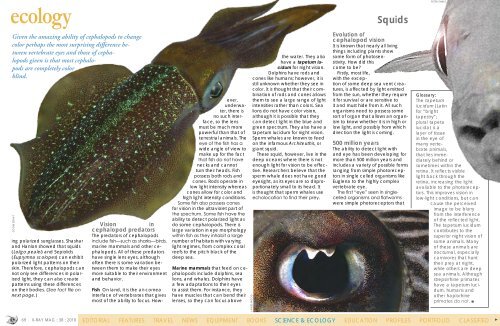Medium resolution version of X-Ray Magazine (96 dpi)
Medium resolution version of X-Ray Magazine (96 dpi)
Medium resolution version of X-Ray Magazine (96 dpi)
You also want an ePaper? Increase the reach of your titles
YUMPU automatically turns print PDFs into web optimized ePapers that Google loves.
ecology<br />
Squids<br />
Given the amazing ability <strong>of</strong> cephalopods to change<br />
color perhaps the most surprising difference between<br />
vertebrate eyes and those <strong>of</strong> cephalopods<br />
given is that most cephalopods<br />
are completely color<br />
blind.<br />
James Wood<br />
ing polarized sunglasses. Shashar<br />
and Hanlon showed that squids<br />
(Loligo pealei) and Sepiolids<br />
(Euprymna scolopes) can exhibit<br />
polarized light patterns on their<br />
skin. Therefore, cephalopods can<br />
not only see differences in polarized<br />
light, they can also create<br />
patterns using these differences<br />
on their bodies. (See fact file on<br />
next page.)<br />
Vision<br />
in<br />
cephalopod predators<br />
The predators <strong>of</strong> cephalopods<br />
include fish—such as sharks—birds,<br />
marine mammals and other cephalopods.<br />
All <strong>of</strong> these predators<br />
have single lens eyes, although<br />
<strong>of</strong>ten there is some variation between<br />
them to make their eyes<br />
more suitable to their environment<br />
and behavior.<br />
Fish On land, it is the air-cornea<br />
interface <strong>of</strong> vertebrates that gives<br />
most <strong>of</strong> the ability to focus. However,<br />
underwater,<br />
there is<br />
no such interface,<br />
so the lens<br />
must be much more<br />
powerful than that <strong>of</strong><br />
terrestrial animals. The<br />
eye <strong>of</strong> the fish has a<br />
wide angle <strong>of</strong> view to<br />
make up for the fact<br />
that fish do not have<br />
necks and cannot<br />
turn their heads. Fish<br />
possess both rods and<br />
cones. Rods operate in<br />
low light intensity whereas<br />
cones allow for color and<br />
high light intensity conditions.<br />
Some fish also possess cones<br />
for vision in the ultraviolet part <strong>of</strong><br />
the spectrum. Some fish have the<br />
ability to detect polarized light as<br />
do some cephalopods. There is<br />
large variation in eye morphology<br />
within fish as they inhabit a large<br />
number <strong>of</strong> habitats with varying<br />
light regimes, from complex coral<br />
reefs to the pitch black <strong>of</strong> the<br />
deep sea.<br />
Marine mammals that feed on cephalopods<br />
include dolphins, sea<br />
lions, and whales. Dolphins have<br />
a few adaptations to their eyes<br />
to assist them. For instance, they<br />
have muscles that can bend their<br />
lenses, so they can focus above<br />
James Wood<br />
the water. They also<br />
have a tapetum lucidum<br />
for night vision.<br />
Dolphins have rods and<br />
cones like humans; however, it is<br />
still unknown whether they see in<br />
color. It is thought that their combination<br />
<strong>of</strong> rods and cones allows<br />
them to see a large range <strong>of</strong> light<br />
intensities rather than colors. Sea<br />
lions do not have color vision,<br />
although it is possible that they<br />
can detect light in the blue and<br />
green spectrum. They also have a<br />
tapetum lucidum for night vision.<br />
Sperm whales are known to feed<br />
on the infamous Architeuthis, or<br />
giant squid.<br />
These squid, however, live in the<br />
deep oceans where there is not<br />
enough light for vision to be effective.<br />
Researchers believe that the<br />
sperm whale does not have good<br />
eyesight, as its eyes are so disproportionately<br />
small to its head. It<br />
is thought that sperm whales use<br />
echolocation to find their prey.<br />
Evolution <strong>of</strong><br />
cephalopod vision<br />
It is known that nearly all living<br />
things including plants show<br />
some form <strong>of</strong> photosensitivity.<br />
How did this<br />
come to be<br />
Firstly, most life,<br />
with the exception<br />
<strong>of</strong> some deep sea vent creatures,<br />
is affected by light emitted<br />
from the sun, whether they require<br />
it for survival or are sensitive to<br />
it and must hide from it. All such<br />
organisms need to possess some<br />
sort <strong>of</strong> organ that allows an organism<br />
to know whether it is in high or<br />
low light, and possibly from which<br />
direction the light is coming.<br />
500 million years<br />
The ability to detect light with<br />
and eye has been developing for<br />
more than 500 million years and<br />
includes a variety <strong>of</strong> possible forms<br />
ranging from simple photoreceptors<br />
in single celled organisms like<br />
Euglena to the highly complex<br />
vertebrate eye.<br />
The first “eye” seen in singlecelled<br />
organisms and flatworms<br />
were simple photoreceptors that<br />
Peter Symes<br />
Glossary:<br />
The tapetum<br />
lucidum (Latin<br />
for “bright<br />
tapestry”;<br />
plural tapeta<br />
lucida) is a<br />
layer <strong>of</strong> tissue<br />
in the eye <strong>of</strong><br />
many vertebrate<br />
animals,<br />
that lies immediately<br />
behind or<br />
sometimes within the<br />
retina. It reflects visible<br />
light back through the<br />
retina, increasing the light<br />
available to the photoreceptors.<br />
This improves vision in<br />
low-light conditions, but can<br />
cause the perceived<br />
image to be blurry<br />
from the interference<br />
<strong>of</strong> the reflected light.<br />
The tapetum lucidum<br />
contributes to the<br />
superior night vision <strong>of</strong><br />
some animals. Many<br />
<strong>of</strong> these animals are<br />
nocturnal, especially<br />
carnivores that hunt<br />
their prey at night,<br />
while others are deep<br />
sea animals. Although<br />
strepsirrhine primates<br />
have a tapetum lucidum,<br />
humans and<br />
other haplorhine<br />
primates do not. ■<br />
69 X-RAY MAG : 38 : 2010 EDITORIAL FEATURES TRAVEL NEWS EQUIPMENT BOOKS SCIENCE & ECOLOGY EDUCATION PROFILES PORTFOLIO CLASSIFIED
















